![]()
![]()
![]()
Use LEFT and RIGHT arrow keys to navigate between flashcards;
Use UP and DOWN arrow keys to flip the card;
H to show hint;
A reads text to speech;
20 Cards in this Set
- Front
- Back
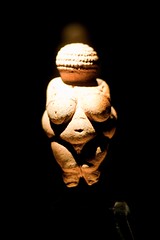
|
Woman of Willendorf
c. 24,000 BCE The woman of Willendorf contributes to the understanding of communication between clans at this time due to similarities in Paleolithic figures while suggesting survivance and fertility through the representations of an exaggerated female body using large rounded features and curved attributes. |
|

|
Hall of Bulls from Lascaux Caves
c. 15,000 BCE The Hall of Bulls is a sophisticated perspective of representing space by taking advantage of the shapes and space of the caves where these animals were depicted, while offering a possible connection between tribes to share hunting techniques and strengthen bonds with the portrayal of animals in close proximity to each other and using the composite pose to portray energy and strength. |
|
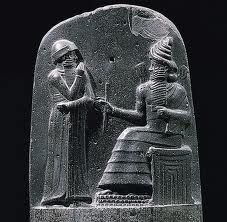
|
Stele of Hammurabi
c. 1792-1750 BCE The Stele of Hammurabi is important because it conveys a visual communication that depicts political stratification and records the understanding about justice between God and man while emphasizing Hammurabi's rule based on regulating laws through the use of cuneiform signs that communicate the laws themselves and the use of hierarchic scale to contribute to the conversation of the ruler as God and/or man. |
|

|
Palette of Narmer
c. 2950 BCE The Palette of Narmer represents the unification of Egypt and growth as a powerful nation-state, conveyed through the use of hieroglyphs that name the kings, pictures of animals that could symbolize defeat of an enemy and depressions that indicate this palette was of ceremonial use, compared to functional. |
|

|
Khafre
c. 2520-2494 BCE This is an important representation of an enthroned king that symbolizes permanence, dignity and regal authority. The use of gneiss portrays a strong and stoic expression of calm and the headdress, kilt and beard contribute to the ideas of royalty. |
|

|
Seated Scribe
c. 2450-2325 BCE This sculpture is a life-like representation of a lively and informal scribe, demonstrating the vocational aspects of the egyptians with a human presence that is conveyed through a slighting sagging body and rounded attributes that are similar to a human face indicating he may be trying to make eye contact with someone. |
|
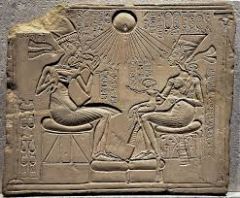
|
Akhenaten and His Family
c. 1353-1336 BCE This is a sunken relief that demonstrates the radical changes in artistic conventions at this time. Showing Akhenaten, Nefertiti and their children, the androgynous figures shows sagging features and a stylized head that help contribute to evoking human emotion. |
|

|
Cycladic Figure of a Woman
c. 2600-2400 BCE This figure is important because it contributes to the understanding of the treatment of bodies and daily life. The angled lines potentially describe sacrificial rituals or decoration with tattooing or the way in which people prepared themselves for burial, along with the gaze of the eyes either focused on a pregnant belly or off into the distance offering attention to healing powers of a particular part of the body. |
|
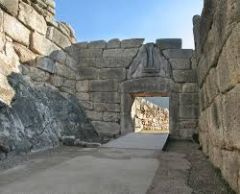
|
Lion Gate from Citadel at Mycenae
c. 1250 BCE A defensive structure, this gate represented power and wealth through the use of regal symbols and was both functional and necessary. Stylized lions (although possible griffins or sphinxes) with their gleaming view portray power by facing outward and magnifying the mixed material in which they were created giving a sense an even higher sense of power and defense to the Citadel at Mycenae. |
|
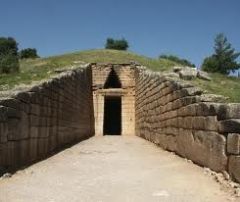
|
Treasury (Tholos) of Atreus
c. 1300-1200 BCE This semi-subterranean beehive style piece of architecture was lead up to by an open-air walkway that exposed and distinguished the corbeled vault roof that was an engineering victory, important because of the distribution of weight with the use of different stacked courses of ashlar and the connection between this semi-underground burial place and the magnificence of such. |
|
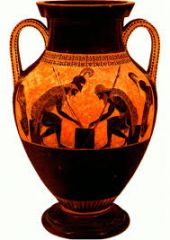
|
Exekias, Ajax and Achilles Playing a Game
c. 540-530 BCE This Amphora is important because of the irony of the piece. Represented by painted figures, Ajax and Achilles play a game of dice and after reentering into battle, Achilles is killed and Ajax takes his own life in despair. The incised lines and dense patterns on this black-figure vessel create a sense of 3D human form and the importance becomes the fact that there is no implication of gods or kings, but humble warriors that help portray the Greek's ideas of human values of truth, virtue and harmony. |
|
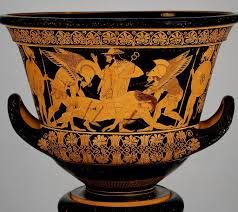
|
Euphronios (painter) and Euxitheos (potter), The Death of Sarpedon
c. 515 BCE This piece is important because of the detail that describes the death of this warrior and the scene of sleep and death on either side of Sarpedon. The use of foreshortening and naturalistic poses give this vessel drama and life-like representations that ultimately prove the artists ability to project the scene into the viewers space. Not only was this piece helpful in the story of a scene from the Trojan War, but it is also a functionally prevalent vessel, use for carry liquids such as wine or water. |
|
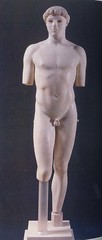
|
Kritios Boy
c. 475 BCE Kritios boy marks one of the first instances that viewers see the contrapposto pose and is important because of the way the figure, although calm and portrayed with a strong self-confidence and seriousness, looks as though it could be in motion at any second, and the standard that this sculpture set for the classical excellence. The slight difference in height of the shoulders and offset hips give Kritios boy an extreme life-like active stance and invites the viewer to look around the entire piece with the slight turn of the head. |
|

|
Parthenon from Athenian Acropolis
c. 447-432 BCE The Parthenon is important because of the proportion of harmony and balance and the ideological themes that are portrayed throughout the architecture. Commissioned as a new temple for Athena and requiring mathematical and mechanical skills, proportion was key in both the structure and the harmonious look of the building. The decoration, especially on the entablatures, show the triumph of an enlightened Greek civilization. |
|

|
Laocoön and His Sons (Roman Copy)
1st Century CE An illustration of a scene from the Trojan war, the Laocoön tells a story of the Gods who supported the Greeks and is important because of the resemblance to the relief on the pergamon, but also because of the way that the diagonal representations of the arms and legs move back and forth through the sculpture, moving the views eyes all around the intwined snakes and idealized male forms. |
|

|
Pont du Gard
Late 1st Century BCE This early Roman use of the rounded arch and the creation of the bridge/aqueduct system was a technological feat that supported the empire. The proportion, balance and rhythm are harmonious in a natural setting. The use of the arch enabled Roman growth and was a technological ingenuity with an important function of bringing water to the empire. |
|

|
Spoils from the Temple in Jerusalem from Arch of Titus
c. 81 CE This particular Spoil from the Arch of Titus is important because is is a static and fixed moment that demonstrates time and space through the representation of a war victory, accumulation of wealth, and the ultimate power of the emperor Titus, shown by the relief of the procession that heads off to the right of the piece and evokes a chaotic emotion. |
|

|
Pantheon
c. 110-128 CE The Pantheon is important because this temple was a place in which people could communicate with the cosmos. As a way of connecting to the cosmos and creating a sense of disconnect from the outside, but a pure sense of the space that they are in, the perfect spherical rotunda and oculus that lets natural light in the building in a way that accents the spherical shape gives the observer a sense that although seemingly disconnected from the outside world, they are quite magnificently connected to the cosmos. |
|
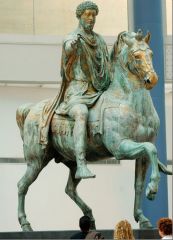
|
Equestrian Statue of Marcus Aurelius
c 176 CE The Equestrian statue is important because of this object used as propaganda, and the reference this sculpture would serve to be for future artists. As strong as a military commander and proud of his success intellectually, the sculpture portrays this emperor without armor or weapons, indicating divine conquering while depicting perfect balance between sizes of the horse and man. |
|
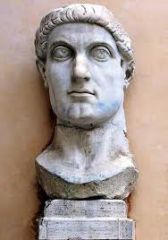
|
Colossal Head of Constantine the Great
325-326 CE The importance of this stand-in sculpture was just that, to be used when Constantine wasn't in Rome. A stylized and symmetrical sculpture, the monumental size and use of life-like facial features convey power and dignity without the frailty or imperfection of a human. |

